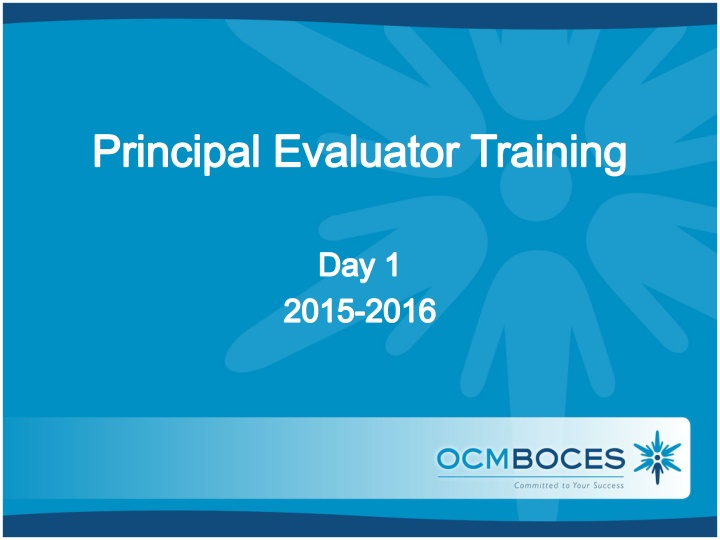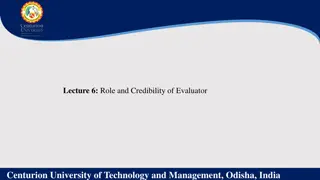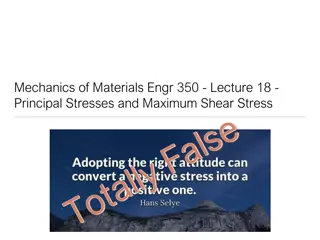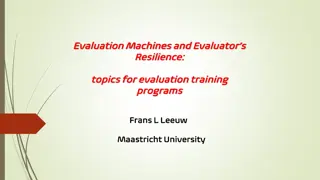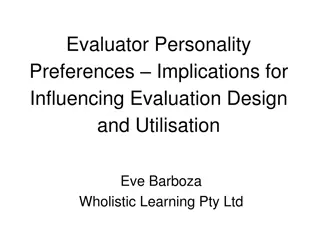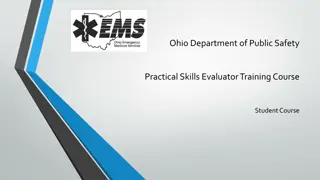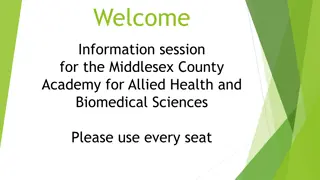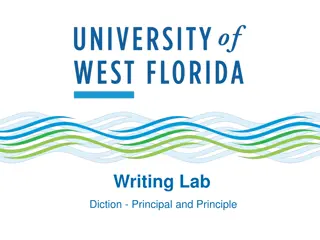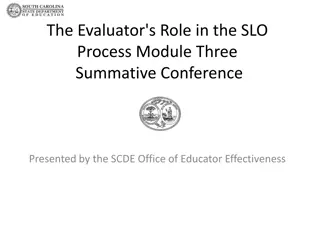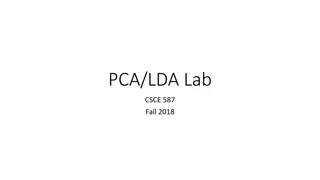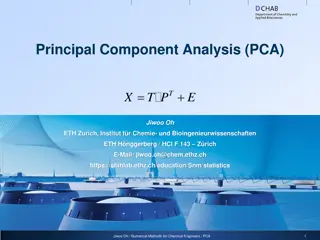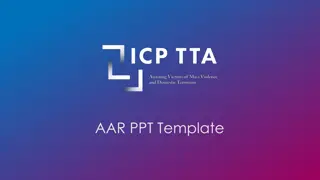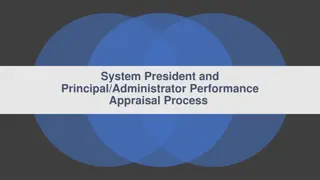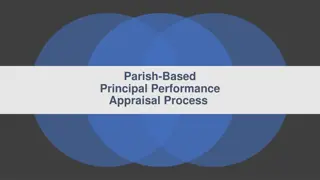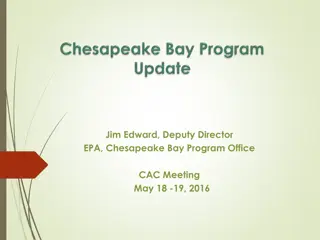Principal Evaluator Training Day 1 - Agenda and Components
This document outlines the agenda, objectives, and required components of a Principal Evaluator Training Day 1 session for the 2015-2016 academic year. It includes information on research updates, negotiation strategies, and supporting local principals through evidence-based observations and assessment tools.
Download Presentation

Please find below an Image/Link to download the presentation.
The content on the website is provided AS IS for your information and personal use only. It may not be sold, licensed, or shared on other websites without obtaining consent from the author.If you encounter any issues during the download, it is possible that the publisher has removed the file from their server.
You are allowed to download the files provided on this website for personal or commercial use, subject to the condition that they are used lawfully. All files are the property of their respective owners.
The content on the website is provided AS IS for your information and personal use only. It may not be sold, licensed, or shared on other websites without obtaining consent from the author.
E N D
Presentation Transcript
Principal Evaluator Training Day 1 2015-2016
Agenda Introductions Objectives and Agenda Review Research SED Update: Principal Scores Negotiations Questions Support Your Local Principal
Nine Required Components 3012-c 3012-d 1. New York State Teaching Standards and Leadership Standards Evidence-based observation Application and use of Student Growth Percentile and VA Growth Model data Application and use of the State-approved teacher or principal rubrics Application and use of any assessment tools used to evaluate teachers and principals 1. New York State Teaching Standards and Leadership Standards Evidence-based observation Application and use of Student Growth Percentile method Application and use of the State-approved teacher or principal rubrics Application of assessment tools the district employs 2. 2. 3. 3. 4. 4. 5. 5.
Nine Required Components 3012-c 3012-d 6. Application and use of State-approved locally selected measures of student achievement Use of the Statewide Instructional Reporting System Scoring methodology used to evaluate teachers and principals Specific considerations in evaluating teachers and principals of ELLs and students with disabilities 6. Application and use of State-approved locally selected measures of student growth Use of the Statewide Instructional Reporting System Scoring methodology used by the state and the district Specific considerations in evaluating teachers and principals of ELLs and students with disabilities 7. 7. 8. 8. 9. 9.
Back Again : 9+ Components 10.State-determined district-wide student growth goal setting process (Student Learning Objectives) 11.Effective supervisory visits and feedback 12.Soliciting structured feedback from constituent groups 13.Reviewing school documents, records, state accountability processes and other measures 14.Principal contribution to teacher effectiveness 15.Increasing the likelihood that it makes a difference
Agenda Introductions Objectives and Agenda Review Research SED Update: Principal Scores Negotiations Questions Support Your Local Principal
Opening Activity: What Matters Most?
What Matters On the organizer, list the things you most value in a principal.
Research & Literature Review
Principal Conversations LeFevre, D. M. & Robinson, V. M. (2015) The interpersonal challenges of instructional leadership: Principals effectiveness in conversations about performance issues. Educational Administration Quarterly, 51(1), p. 58-95.
Principal Conversations Three barriers to effective instructional leadership: 1. Administrative tasks distract from the core business of improving teaching and learning 2. Leaders inadequate knowledge about effective teaching and learning 3. Skill to help teachers improve
Principal Conversations Three barriers to effective instructional leadership: 1. Administrative tasks distract from the core business of improving teaching and learning 2. Leaders inadequate knowledge about effective teaching and learning 3. Skill to help teachers improve
Principal Conversations Principals and teacher performance issues: The most common response to teacher incompetence has been to tolerate, protect and/or avoid Conversations have avoided the truth It s hard to give negative feedback after years of double-talk and ceremonial congratulations YET: Most teachers and administrators agree that the number of teachers who receive unsatisfactory evaluations is less than actual number of unsatisfactory teachers
Principal Conversations Productive conversations depend on principal being able to (from least important to most): 1. Express a grounded point of view 2. Seek deeper understanding of the other s point of view 3. Check for understanding 4. Help other to consider other point of view 5. Consider other points of view 6. Reach agreement about effective and integrative solutions
Principal Conversations Productive conversations depend on principal being able to (from least important to most): 1. Express a grounded point of view 2. Seek deeper understanding of the other s point of view 3. Check for understanding 4. Help other to consider other point of view 5. Consider other points of view 6. Reach agreement about effective and integrative solutions
Principal Conversations Are there patterns in principals difficult conversations (with parents, teachers, and both)? Principals have modest skill level More consistently closed conversations rather than open Jump to solutions prior to through consideration (less inquiry)
Principal Conversations Conclusion: The overall modest to low skill levels demonstrated [in the study] highlight the need to provide leaders with sustained, high-quality opportunities to learn how to effectively deal with difficult conversations Some of this comes from Lead Evaluator Training, but more is needed. From where?
What Matters On the organizer, list the things you most value in a principal.
SED Information: Principal and Teacher Scores from the State
mean Range (9.2%) Developing Ineffective Range (6.7%) Highly Effective Range (6.7%) Effective Range (77.4%) SD = -1.5 SD = 0 SD = -1 SD = +1.5 SD = +2 6% 16% 50% 94%
SGPs to MGPs for Principals To measure principal performance, we find the mean growth percentile (MGP) for all her students who were enrolled on BEDS day and assessment day. To find a principal s mean growth percentile, take the average of SGPs in the school: Principal Jensen s School SGP BEDS- Assessment Day Enrollment Yes Student Q 45 Student R 40 Yes Step 1: 45+40+70+41 = 196 Student S 70 Yes Student T 60 No Step 2. 196/4 = 49. Student U 41 Yes Principal Jensen s mean growth percentile (MGP) is 49, meaning on average her students performed as well or better than 49 percent of similar students. Same minimum sample size requirements (16 student scores) for principals as for teachers.
GREs for Principals Simplified Illustrative Example Student Number of Regents Passed This Year For This Student Number of Regents Passed This Year by Similar Students Difference Principal s score on this metric is 0.2. On average, students at this school are passing 0.2 Regents Exams more than similar students statewide. A zero represents average or effective results. Jessica 1 1 0 Tyler 2 2 0 Ashley 1 2 -1 Emily 3 2 1 Jacob 3 2 1 Total Difference (Sum of Differences) 1 Average Difference (Total Difference/Number of Students) 1/5 = .2 NOTE: 0 means student or school achieved the average (or effective ) result compared to similar students statewide.
Distribution of HEDI Labels State-Provided Teacher and Principal Scores mean Range (9.2%) Developing Ineffective Range (6.7%) Highly Effective Range (6.7%) Effective Range (77.4%) SD = -1.5 6% SD = 0 50% SD = -1 16% SD = +1.5 SD = +2 94%
Assigning Points to HEDI Labels Previous Distribution 0 1 2 18 19 20 3 4 5 6 7 8 9 10 11 12 13 14 15 16 17 Ineffective Range (6.7%) Highly Effective Range (6.7%) Range (9.2%) Developing Effective Range (77.4%) SD = -1.5 SD = 0 SD = -1 SD = +2 SD = +1.5 6% 16% 50% 94%
Assigning Points to HEDI Labels Future Distribution 18 19 20 0 1 2 3 4 5 6 7 8 9 10 11 12 13 14 15 16 17 Ineffective Range (6.7%) Highly Effective Range (6.7%) Range (9.2%) Developing Effective Range (77.4%) SD = -1.5 SD = 0 SD = -1 SD = +2 SD = +1.5 6% 16% 50% 94%
3012-c to 3012-d Scoring Bands 3012-c Bands 3012-d Bands HEDI Points Min MGP Max MGP Min MGP Max MGP KEY Description 0 9 28 9 22 1 29 31 23 24 Well-below state average for similar students Ineffective 2 32 35 25 25 3 28 35 26 26 Below state average for similar students Developing 4 36 36 27 27 5 37 37 28 28 Results meet state average for similar students Effective 6 38 38 29 29 7 39 39 30 30 Highly Effective Well-above state average for similar students 8 40 41 31 31 9 36 43 32 32 10 44 45 33 33 11 46 48 34 34 12 49 50 35 35 13 51 52 28 37 14 53 55 38 41 *For illustrative purposes only. 3012-d scoring bands were not in place for most teachers during 2014-15. The minimum and maximum MGPs associated with each point range may change in future years based on the MGPs of teachers statewide. 15 56 57 36 48 16 58 60 49 55 17 61 69 56 69 18 67 68 67 68 19 69 72 69 72 20 73 97 73 97
SED Information: Principal and Teacher Scores from the State
Details to Work Out Number site visits Independent Evaluator or not Whether to use a supplemental measure Scoring ranges Those other details
Tool School Visits
Questions and Visits What questions do you ask when you meet with your principal? When you go on a school visit?
Questions and Visits Each person at your table groups should pick a different page to review. After all have been examined, take turns, in order, to review them. What questions and look-fors would you add?
What Matters On the organizer, list the things you most value in a principal.
What Matters Now list your principals across the top
What Matters Shade in the areas when you can recall EXPLICITLY addressing the valuable quality with the principals you ve identified. Look at your heat map
Principal Learning Principals report that while they are attempting to create conditions to support learning for others, their own learning is not well supported.
Principal Learning What are you planning to Help your principal(s) with time management Increase the inter-rater reliability and agreement among your lead evaluators Help principals plan their faculty meetings Help principals remain positive and be good leaders Help principals with their learning Helping principals with their conversations
Next Session February 10th: 12:00p - 3:00p Agenda will include: Updates Research Feedback More
Principal Evaluator Training Day 1 2015-2016
